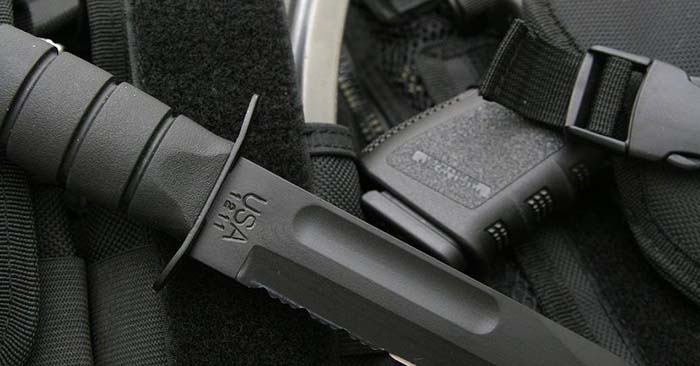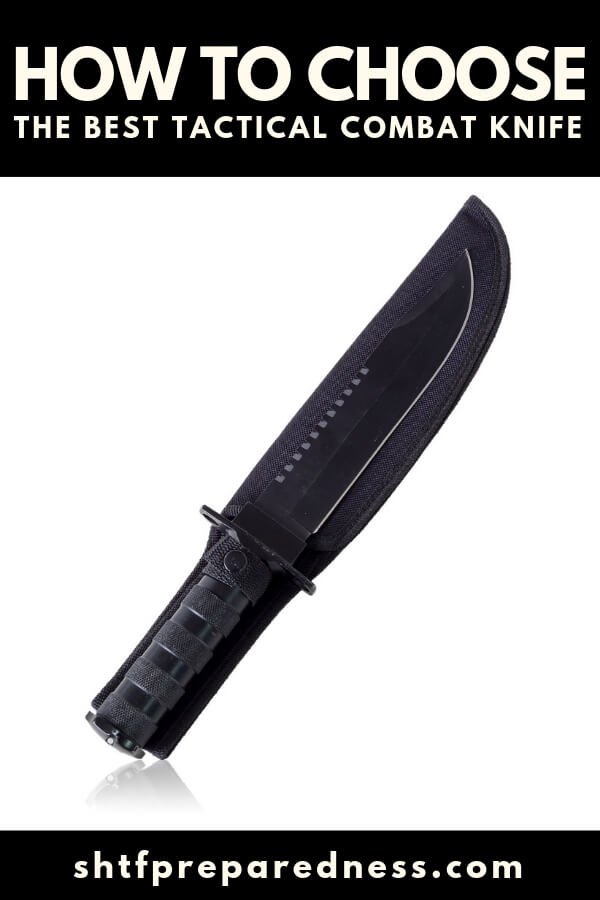SHTFPreparedness may collect a share of sales or other compensation from the links on this page.
A tactical combat knife is a knife designed for combat and other military purposes. Typically this means it is a last-ditch weapon for hand-to-hand combat, but more expansively it could be considered a knife for the tasks one is likely to encounter in combat. I’ll be considering the former meaning, as I think it is the intuitive meaning of the phrase, and there is little overlap between the two meanings.
What Is the Purpose of Your Knife?
The purpose of your tactical combat knife is to fight your way to your handgun or your rifle. Specifically, it’s a tool for doing maximum damage to the enemy’s body while avoiding damage to your own body.
This damage will normally be accomplished through cutting and stabbing, but may also involve blunt trauma.
Fixed Blade or Folding Tactical Combat Knife
Which one would be best — fixed blade or folding?
A tactical folding knife has an inevitable and inherent mechanical weakness at the folding point. It is thus likely to break under stresses that would pose no problem for a tactical fixed blade. The advantage of a folding blade is that it can be carried in a pocket for concealment and weight reduction (no sheath).
Given that we’re discussing a combat knife — not a self-defense knife — I consider the concealment advantage extremely minor. More important is the slower deployment of a folding knife.
Even the fastest assisted opening knife or switchblade can’t be as quick as a fixed blade.
Considering the Blade Length
Let’s consider the blade length and overall length of the fixed blade tactical combat knife. Factors that favor a shorter length include concealability, deployability, and weight. Factors that favor a longer length include penetration and reach. Generally, I would recommend a longer blade, but there are practical limits to the length.
Small Tactical Combat Knife
Let’s start with the pros and cons of the small fixed-blade combat knife.
A shorter hilt is more difficult to control, presenting a safety issue for the user. A shorter knife will be lighter (all else being equal), more concealable, and slightly faster to deploy, but will not penetrate as deeply into the enemy’s body, and will not reach as far.
Medium Tactical Combat Knife
Now, consider the pros and cons of the medium fixed blade combat knife.
The medium knife’s hilt fills the hand sufficiently for a safe grip, and the blade pierces nearly as deeply and reaches nearly as far as the long knife. Yet, it retains some of the concealability, deployability, and weight advantages of the small knife.
Large Tactical Combat Knife
Finally, let’s analyze the pros and cons of the large tactical fixed blade combat knife.
In actual combat, this is the king of knives. Sometimes people think that a long combat knife means a machete knife. But it is not necessarily true.
The length of the knife’s deep penetration and extended reach enhance lethality. Downsides include exponentially more time carrying the extra ounces than enjoying the tactical advantages. Also, the extra split second it can take the longer blade to clear the sheath could be devastatingly crucial in combat.
Choosing the Blade Material
Choosing a blade material is probably the most important part of choosing a tactical combat knife. The three basic attributes to consider are corrosion resistance, toughness, and hardness.
Improving any given attribute generally increases your price, and normally you have to choose two of the three to focus on.
SM100 is the only metal I’m aware of that excels in all three attributes. If you can’t afford SM100, I recommend choosing a hard metal, that’s also corrosion-resistant, and finally is reasonably tough.
Note that heat treatment affects performance as much as the metal itself does.
Selecting the Blade Shape or Tip
Let’s consider the shape of the tactical combat knife blade tip and edge. Remember that the tip is primarily for stabbing, and the edge needs to cut cleanly without excessive dulling.
Drop Point
The back of the drop point blade slowly curves down from the handle to the tip. This makes a strong, controllable point, but one that is suboptimal for stabbing. Since stabbing is an important feature of a combat knife, the drop point is probably not a good choice.
Clip Point
The first half of a clip point blade is straight from the handle, and then it turns down in a straight or curved line to the tip, giving the appearance of part of the blade being clipped away. This point is very sharp for stabbing, but it is slightly weak.
Spear Point
A spear point is symmetrical with a central spine and usually is at least partially double-edged. This design is strong, sharp, and controllable, but if the double edge extends more than an inch or two back it can limit handling options in combat: you can’t apply pressure to the back of the blade if both sides are sharp.
Scandi Point
A Scandi “point” actually refers to the grind of the blade edge. It starts about halfway through the blade and tapers uniformly to the edge. This allows for a very sharp edge, but it’s difficult to create and maintain. Sharpening so much of the blade leaves it weaker than otherwise.
Hollow Point
A hollow “point” also refers to the grind of the blade edge. It’s a concave grind starting about halfway through the blade with a bevel at the edge that is the actual sharpened edge. This grind makes the blade lighter, but weaker, and it can be pretty sharp.
Full Convex
A full convex blade also refers to the grind of the blade edge. It’s a gentle convex from the back of the blade to the edge. This makes for a strong blade with good edge retention, but it’s a difficult edge to create and maintain.
Blade Spine
Let’s consider the tactical combat knife spine. On a single edge blade, this is the flat part opposite the edge. On a double-edged blade, it is central to the two edges. Either way, a thicker spine is stronger and usually preferred. On a single edge blade, you may desire to extend the edge back along the front of the spine.
Blade Edge
Let’s examine the combat knife blade edge — not the sharpening style as we have already considered, but whether the edge should be serrated, saw-tooth, or plain. Each kind of edge has pros and cons, but we can figure out which one is best for a tactical combat knife.
Plain Edge
Let’s reflect first on the plain edge of the combat knife blade. This is the traditional edge, and there’s nothing wrong with it. Properly sharpened it will do its job admirably. It is easier to sharpen than serrated or saw-tooth blades, but it needs sharpening more frequently because it has less surface area for cutting.
Serrated and Saw-Tooth
Now, consider the serrated and saw-tooth edges on the tactical combat knife. Serrated and saw-tooth blades can offer some cutting advantages in secondary uses of the combat knife, but in its primary use, these blades can get caught in ribs during the stabbing. Therefore, I do not recommend selecting a serrated or saw-tooth blade for a combat knife.
Partially Serrated Edge
Finally, contemplate the combination or partially serrated edge on the tactical combat knife. If the serration is on the spine, it limits handling options as much as a conventional double edge does. Regardless, partial serration catches on ribs nearly as much as full serration, so I caution against this edge style.
The Rest of the Knife
Knife Tang
Let’s consider the knife tang for a fixed blade tactical combat knife.
There are three options: full tang (blade extends at full width to the back), partial tang (blade extends at full or reduced width partly through the handle), and rat-tail (blade extends at significantly reduced width through the handle).
Full tang is the strongest but heaviest. Partial tang is most likely to break. Rat-tail is lighter but still strong enough. I recommend full tang.
Knife Handle
Let’s think about the tactical combat knife handle. The blade gets more attention because it’s more glamorous, but the handle is hardly less important.
Primarily, it should offer a firm grip even when slick with mud, blood, or sweat. Being slightly oversized helps with this.
The material should be sturdy, comfortable, and waterproof while providing a solid purchase in all conditions. A crossguard (preferably two quillons) is an important safety feature.
Brass knuckles or a solid metal knuckle guard built into the handle add some weight, but also expand your options in combat to include blunt trauma.
Knife Pommel
The pommel primarily functions to stabilize the handle structure as part of the tang or as an end cap. However, it is also an opportunity to incorporate a blunt trauma tool into the tactical combat knife with a spike or pyramid shape.
A pommel that’s too pointy prevents you from pushing on the pommel in combat.
Knife Sheath
The sheath has two related functions: it must keep your knife secure until you need it, and it must prevent the blade from piercing through to stab or cut you.
Sheaths commonly attach to the belt but may be attached instead to the gear by MOLLE or clipped onto the boot. Good materials for sheaths include leather, Kydex, and nylon. In all cases, make sure that any stitching is on the opposite side of the blade edge.
